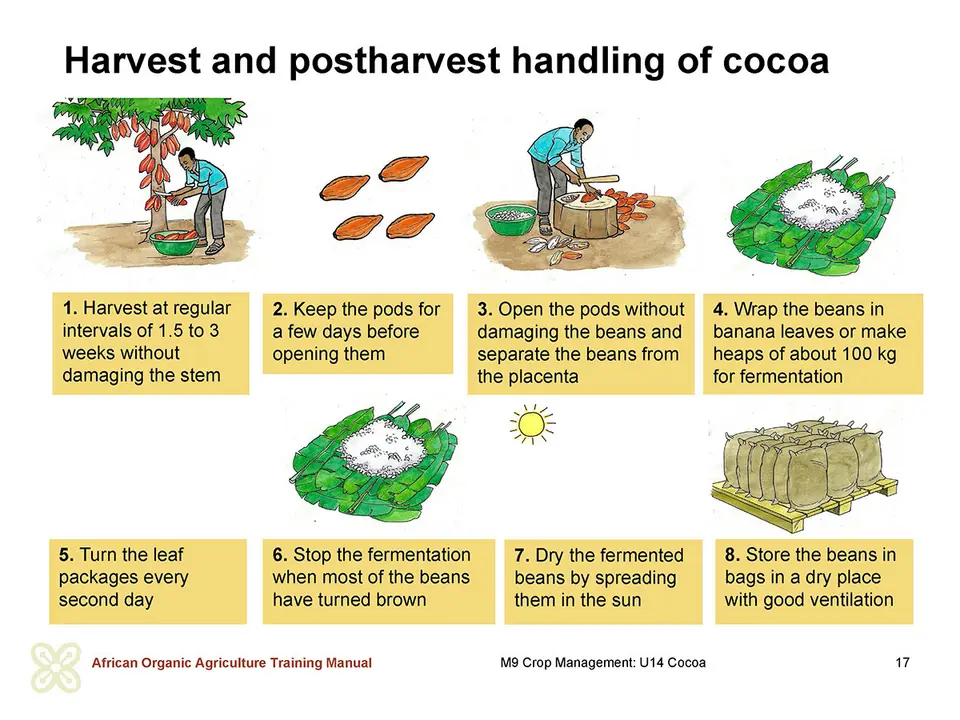Postharvest handling of cocoa
Harvesting
Depending on the temperature, pod ripening can take between 4.5 to 7 months from flowering. Pods must be harvested when they are fully ripe with a visible orange or yellow shell. Beans from unripe pods produce low quality cocoa. Ripe pods should be removed as soon as possible in order to minimise attack by fungal diseases or animal pests. In addition, ripe beans can germinate inside the pod, which has a negative effect on the cocoa quality.
Recommendations for harvesting:
- Harvesting should be carried out at regular intervals of 1.5 to 3 weeks.
- Pods must be cut off the tree with knives without damaging the stem on which further fruits will form.
- After harvesting, pods can be kept for a few days before opening. Such a delay has been found to be advantageous in improving the cocoa quality.
- Pods then have to be opened for the removal of the beans. It is important to separate the beans from the placenta. Either the pods are opened in the field and only the beans moved for fermentation or the pods are transported and opened near the fermenting kegs. To reduce the risk of damaging the beans, the pods are to be cracked on a hard surface (stone or wood) or by hitting them with a piece of wood.
Discussion on postharvest handling of cocoa
Inquire among the farmers, how they handle cocoa during and after harvesting and up to storage of dried beans. Identify any shortcomings in the methods and procedures that are locally used and advise accordingly on improvements needed in order to improve the quality of dried cocoa beans.
Fermentation
Beans must be fermented as soon as they are removed from the pod. Fermentation has four objectives:
- Removes the mucilage (pulp) attached to the beans.
- Kills the embryo so that the beans cannot germinate.
- Encourages chemical changes within the bean, which produce the substan-ces responsible for the chocolate aroma.
- Reduces the moisture content of the beans.
Fermentation can be carried out in two ways:
Traditionally the beans are heaped or wrapped in banana leaves. Every second day the banana leaf packages are turned over to ensure even fermentation. The size of heaps is determined by the need for a sufficiently high temperature of 40 to 50 °C to permit liquid to drain out and air to circulate freely around the beans. Small quantities of less than about 70 kg will not reach the required temperature, while in heaps of more than 150 kg aeration becomes restricted. The end of the fermentation process is reached when most of the beans are brown. When 75 % of the beans have pale cotyledons in the centre with a brown ring, the fermentation process should be stopped. The process usually takes 6 to 8 days for Forastero and 3 to 5 days for Criollo cocoa.
A second way of fermenting the cocoa beans is by placing them in wooden tray stacked on top of each other and covered. This way saves on work for the farmer and ensures better fermentation. Waste water from the fermentation process should be properly disposed off, for example in other crop fields.
Germinated beans and beans from disease-infested pods should be fermen-ted separately.
Proper drying
Fermented beans must be dried to prevent deterioration. This is mainly done by spreading them out in the sun on concrete floors or raised mats. The beans need to be covered overnight and in rain. Sun drying alone will take at least a week. Foreign matter should be picked out from the beans while they are spread out. Sun drying can be supplemented with hot air in specially-designed drying chambers. Well-dried beans should have a moisture content of about 6 to 7 %. Beans with a moisture content of more than 8 % become mouldy, while beans with moisture below 5 % become brittle. Before packing dried beans into air permeable bags, all flat, broken and poorly fermented beans should be removed.
Proper storage
Due to the high temperature and humidity in the tropics, stored cocoa rapidly gets attacked by storage pests and moulds, because dried cocoa easily absorbs water. In locations with 80 to 90 % humidity, the moisture content of cocoa often increases to more than 10 %. As a result, cocoa loses its storage capacity.
Therefore, for proper storage good ventilation should be ensured. The bags should be stack off the ground, preferably on wooden pallets, and off the wall.
Organic production does neither allow the treatment with methyl bromide nor the application of synthetic storage insecticides. The jute bags used for packing should also not have been treated with pesticides.

 tap and then scroll down to the Add to Home Screen command.
tap and then scroll down to the Add to Home Screen command.